“Oh, can’t you come because the mountains are blocked / Oh, can’t you come because the sea is blocked / We all go to the same hometown and come to the same place / Because the North and the South are blocked, the long-desired thousand miles / Every dream finds you / Every dream finds you / wail sampalseon (the 38th parallel) / Oh, when it blooms in Spring, do you want to come / Oh, do you want to come when it snows / The road we cross over with a bundle / Even the mountain birds wept and climbed with me / for you, Freedom / for you, Freedom / I will give my life for you.”
This song, which expresses the pain of the division between North and South Korea and the situation at the time when the people of two Koreas could not just be happy in the liberation space, is called “Gagara Sampalseon,” and it was released after liberation. Korean aspirations for freedom, peace, and prosperity which came to the Korean Peninsula with the 8.15 liberation of Korea (1945.08.15), soon became an unattainable dream due to different ideologies and the trusteeship of western powers. During the 6·25 War in Korea (1950-53), both Koreas signed an armistice agreement at Panmunjom, signaling the official start of the division. However, the two Koreas are moving forward towards peace on the Korean Peninsula through steady exchanges and diplomatic dialogue at Panmunjom. In this article, a CBT reporter visited Panmunjom, a place of dialogue, peace, and hope.
<The Road to Panmunjom>
On Sept. 21, the road to Panmunjom, the Joint Security Area (JSA) located in the Demilitarized Zone, was a very long way. At 10:00 a.m., the reporter took the KTX from Osong Station to Haengsin Station, and then traveled along the Gyeongui-Jungang Line to Munsan Station, arriving at 12:30 p.m. Soldiers and their families are often seen around Munsan Station, and there were many shops selling military supplies. When the reporter went into the store for lunch, some tables had soldiers having lunch before returning to the unit. After lunch, the reporter waited at Exit 1 of Munsan Station and took the shuttle bus from the Panmunjom Tourist Support Center. At the center, tourists were given instructions and a tour schedule, and immediately boarded the tour bus. During the Panmunjom tour, a total of three lines are crossed: the Civilian Control Line (CCL), the Southern Limit Line (SLL), and the Military Demarcation Line (MDL). After passing the Imjin River and Unification Bridge, tourists will see the CCL. Looking at the view of the Imjin River from the Unification Church and the soldiers in front of the CCL, the reporter experienced complicated feelings. This is because the military atmosphere begins as you get closer to North Korea, and the quiet view of the Imjin River made the early expectations and interest in Panmunjom subject to self-reflection. After passing the CLL and arriving at the United Nations Command Security Battalion - Joint Security Area (UNCSB-JSA), tourists got off the Ministry of Unification bus, and onto the United Nations Command (UNC) bus to start a tour with JSA soldiers and tour center commentators.
<Freedom House>
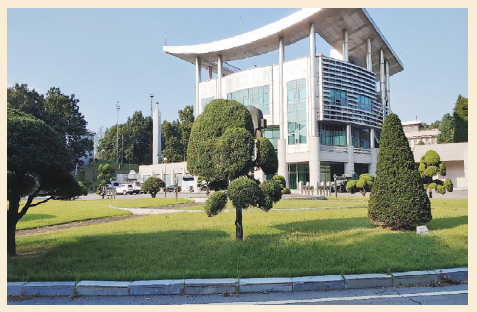
It is the northernmost South Korean facility within the JSA and faces the North Korean Panmungak with the MDL in between. It was also the place where the first meeting between the leaders of the US and Korea was held in June (2019 Koreas–United States DMZ Summit). Currently, it is playing a role in supporting liaison work and talks between the South and North Korean Red Crosses. In the past, liaison between the two Koreas was carried out at the Freedom House in the South and at Panmungak in the North. Freedom House and Panmungak communicate by telephone and fax, and there is a separate conference hall building behind Freedom House and Panmungak. The meeting place in South Korea is called the Peace House, and the meeting place in North Korea is called Tongilgak.
During the tour, the reporter could see a North Korean soldier using a telescope to observe visitors from the left-side window of Panmungak by telescope for about 5-10 minutes. The UNCSB-JSA soldier, who guided the tour, commented that North Korean soldiers were often seen observing South Korean tours.
<MAC’s Conference Row (T2)>
The 7 temporary buildings above the MDL are the meeting rooms of the Military Armistice Commission (MAC), of which 4 gray buildings are administered by North and three blue buildings are administered by the UNC. These three blue buildings are, from left to right, called T1, T2, and T3, with the letter T standing for “temporary.” Originally, people from both sides were able to freely move around inside the JSA, but the area was divided at the MDL after the Ax Murder Incident on Aug. 18, 1976. Since then, in principle, people on one side are not allowed to cross the MDL to the other side. However, the MDL is not in effect inside T2, so visitors can cross the MDL there. The four-meter-wide strip between T2 and T3 was where President Moon and Chairman Kim met and where the leaders of the two Koreas and the U.S. came together. Persons from the south who visit the North return via this strip, and the repatriation of North Koreans is done here as well.
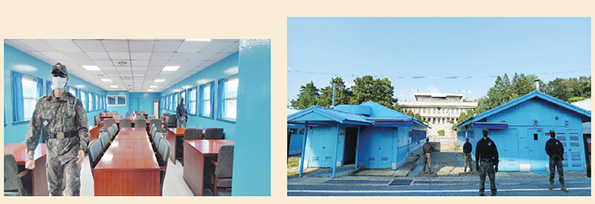
<Commemorative Tree>
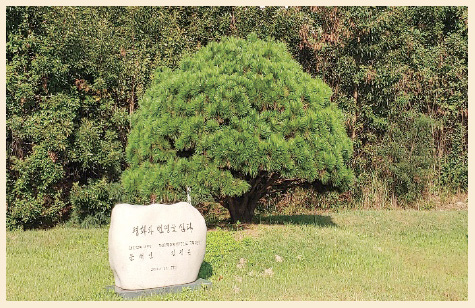
The two Korean leaders replanted a 65-year-old red pine together on the MDL as a symbol of turning 65 years of inter-Korean confrontation and military tension into peace and co-prosperity. The pine was first planted in 1953 after the Armistice Agreement was signed. Thus, the tree has, along with the Korean people, witnessed the pain of a divided Korea for 65 years, and it can also represent the healing of past scars and taking the first step toward peace and co-prosperity. When the tree was replanted in 2018, the two leaders used dirt and water from symbolic mountains and rivers in the two Koreas: Mt. Halla and the Han River in the South and Mt. Baekdu and the Daedong River in the North. The commemorative stone in front of the tree is of granite from Paju city in South Korea, and it is inscribed with the phrase “planting peace and prosperity” made by President Moon. After replanting the tree, President Moon said, “We don’t plant just a pine tree, but plant peace and prosperity.” Chairman Kim responded by saying, “Despite many difficulties, a new spring has come to us. We must cherish and nurture it going forward.”
<Footbridge>
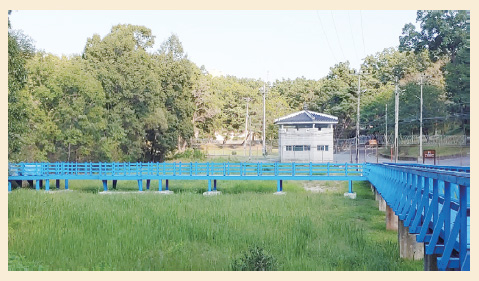
The footbridge is a shortcut over a swamp between the Neutral Nations Supervisory Commission (NNSC) camp, on the South side of the MDL, to Conference Row (T1, T2, T3). It is called Dobo-dari (Walking Bridge) in Korean, and as a UNC facility, the bridge is painted the UN’s official shade of blue. Therefore, it has also come to be known as the Blue Bridge. The footbridge was in the spotlight when the two Korean heads of state crossed it together during the inter-Korean summit on Apr. 27, 2018. Originally built in a simple straight line, the bridge was extended to create a T-shaped structure where the two leaders could sit for refreshments during the summit. A rusty marker bearing the phrase “MDL 101” stands next to the tea table, but the surface is so corroded it is hard to read. The UNC wanted to replace it, but the South Korean government decided to keep the old one because it can represent the pain of division well. Currently, the structure of the T-shaped structure, where the two leaders talked for 30 minutes, is displayed inside the Freedom House.
<After the Tour of Panmunjom>
Looking at the recent diplomatic summits, it seems that only peace dialogue existed in Panmunjom. However, in Panmunjom, there was a reality of division that the reporter had never felt before. It was able to feel the pain of division firsthand, pondering the death of the UN officer who died in the ax atrocity incident, a memorial to Private Jang Myung-ki who died in the defection of Soviet tourist guide Matauzok, and bullet holes left on a building in Panmunjom after a North Korean soldier Oh Chong-song when escaped North. Nevertheless, at the same time, the buildings, the guides, and the JSA soldiers at Panmunjom all have one thing in common they all point to the fact that Panmunjom is a place of dialogue, peace, and hope. This reporter recommends that CBNU students think about peace in a divided country through a tour of Panmunjom.
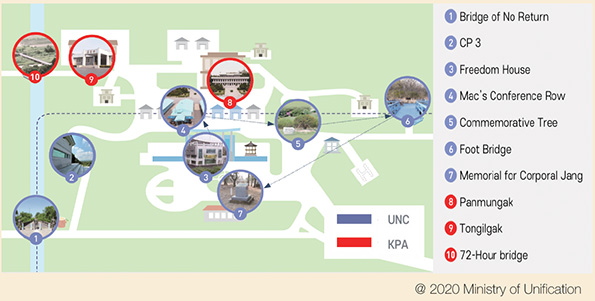
By Park Su-min
psm0129@chungbuk.ac.kr


 All
All Experience
Experience






 Park Su-min
Park Su-min











